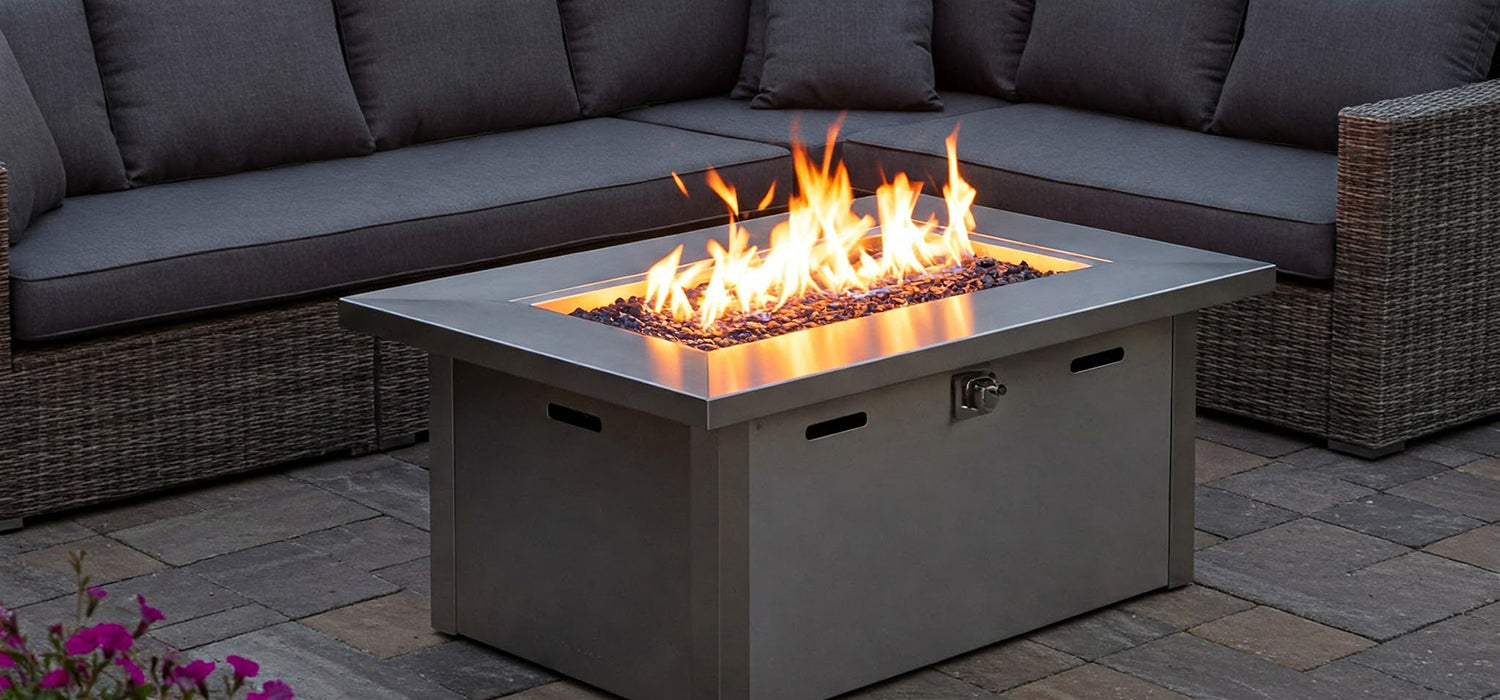
How to Repair Your Outdoor Gas Fire Pit: A Homeowner’s Guide to Fixing Common Problems
Is your outdoor gas fire pit or fire table giving you the cold shoulder? Don’t panic! Repairing your fire pit is easier than you think. Whether it won’t light or has a weak flame, we’ve got you covered with simple fixes that’ll have you cozying up in no time!
Common Outdoor Gas Fire Pit Problems
Outdoor gas fire pits are a fantastic way to add warmth and atmosphere to your garden, but like any outdoor appliance, they can run into a few issues. Let’s take a look at some of the most common problems that may be keeping you from enjoying those chilly evening gatherings around the fire.
Ignition Issues:
Moisture Damage to Igniter or Wiring
One of the biggest headaches is when your fire pit just won’t light. If moisture gets into the ignition system, it can cause the igniter to fail. Imagine standing in front of your fire pit on a cool night, pressing that button, only to hear... nothing. Rain, humidity, or even a bit of morning dew can corrode the igniter and its wiring, preventing a spark from happening.
Dirt and Debris Buildup
Dirt and debris are silent troublemakers. Over time, small bits of dirt, leaves, or even insects can clog up the ignition system, causing it to misfire or fail completely. A simple cleaning can sometimes be all it takes to get things working again. So, next time you’re having trouble lighting your pit, check for any obstructions!
Flame Extinguishing:
Wind and Rain Interference
If you’ve ever been around a fire pit during a sudden downpour or gust of wind, you know how quickly the flames can flicker out. Outdoor fire pits aren’t always protected from the elements, so wind and rain are natural flame killers. To keep your fire pit going strong, consider setting it up in a more sheltered spot or investing in a fire pit cover to protect it from the worst of the weather.
Gas Supply Problems
A weak or intermittent flame is often the result of an issue with the gas supply. Whether it’s a low propane tank or a faulty regulator, when the gas isn’t flowing properly, your fire pit just won’t burn right. If your flame is more “flicker” than “fire,” check your gas levels and ensure everything is properly connected.
Corrosion and Weather Damage:
Rust and Corrosion on Burner and Components
Exposed to rain, wind, and sun, your fire pit will naturally suffer from corrosion and rust. The burner, in particular, is susceptible to these issues, and over time, this can affect its performance. If you notice rust spots on your burner, it could be time for a replacement. Regular cleaning can help prevent this, but if the damage is already done, don’t be afraid to replace parts.
Damage from Sun and UV Rays
It’s not just rain that can wreak havoc on your fire pit. Prolonged exposure to the sun’s harsh UV rays can damage the materials, causing them to fade or crack. This is particularly common with any plastic or rubber parts. A bit of extra care—like using a protective cover—can help extend the life of your fire pit.
Troubleshooting and Repair Steps
Now that we’ve got a sense of what might be causing the problems, let’s jump into how you can fix them. Here are some straightforward troubleshooting steps to get your fire pit back in action.
Cleaning and Inspecting Components:
Cleaning Burner Ports and Ignition System
The first step in any repair job is a thorough cleaning. Over time, dirt, dust, and even small insects can clog the burner ports and ignition system. To clean it out, start by removing the lava rocks or fire glass, and then inspect the burner for any debris. A soft brush or compressed air can do wonders here, clearing out the obstructions and allowing your flame to flow freely again.
Checking for Damage or Corrosion
Once you've cleaned everything, take a good look at the components. Check for any signs of wear, especially around the ignition system, wiring, and burner. If you see any rust, corrosion, or obvious damage, it’s time to replace the part. You’ll be able to find replacement parts at most hardware stores or online, so it’s a relatively easy fix.
Protecting from Weather:
Using Covers and Shields
The elements can be tough on your fire pit, especially if it's left uncovered during bad weather. A good quality cover will keep moisture, dirt, and debris from getting into the system. You can also find protective shields that are designed to keep the wind and rain at bay, so your fire pit remains in good shape even when you're not using it.
Storing Properly When Not in Use
When the fire pit’s not in use, make sure to store it properly. If possible, move it into a sheltered spot, away from direct sunlight, rain, and wind. If it’s too large to move, a well-fitting cover can be your best friend, keeping it protected and ready to go when you need it.
Repairing or Replacing Components:
Replacing Damaged Igniter, Wiring, or Burner
If you’ve cleaned everything and still can’t get your fire pit to work, it’s time to start replacing parts. The igniter, burner, and wiring are the most likely culprits. Fortunately, replacing them is usually a straightforward job. Many fire pits come with a manual, so follow the instructions for part replacements, or consult the manufacturer for guidance.
Adjusting or Replacing the Regulator
If your flame is weak, inconsistent, or doesn’t stay lit, you might need to adjust or replace the regulator. The regulator controls the flow of gas, and if it’s malfunctioning, it could prevent your fire pit from functioning properly. Adjusting the regulator is often a quick fix, but if that doesn’t work, you may need a replacement.
Safety Precautions and Professional Help
When dealing with gas, safety always comes first. It’s important to take the necessary precautions and know when to call in a professional for help.
Gas Leak Detection and Prevention:
Using a Soap Solution and Smelling for Gas
Before you start working on your fire pit, it’s essential to check for any gas leaks. You can do this easily by mixing some soapy water in a spray bottle and applying it to the gas connections. If you see bubbles forming, you have a leak. Always use your nose as well—if you smell gas, turn off the supply and ventilate the area immediately.
When to Hire a Professional:
Complex Repairs or Gas Line Issues
While most fire pit repairs can be handled by a DIY enthusiast, there are times when you’ll need to call in a professional. If you’re dealing with gas line issues, persistent leaks, or electrical faults, it’s best to let a qualified technician handle the job. Gas leaks can be dangerous, and it’s always safer to hire someone who is trained to deal with these problems.
Conclusion
Don’t let a broken fire pit ruin your outdoor fun! With a little bit of elbow grease and these easy-to-follow troubleshooting tips, you can repair your gas fire pit and get it back in working order in no time. Whether it’s cleaning out the burner, replacing faulty parts, or protecting it from the elements, you now have the tools to keep the flames burning bright. But if things get a little too complicated, don’t hesitate to call in a professional to ensure everything is safe and up to code. Now, go ahead—enjoy those warm, cosy evenings around your fire pit once again!
Other content we think you'll love
- How to Light a Gas Fire Pit: The Complete Guide to Safe and Easy Lighting
- How to Fix a Fire Table That Won’t Stay Lit
- How to Fix a Gas Fire Pit: Troubleshooting and Repairs Made Easy
- How to Light a Gas Fire Pit with a Lighter: A Step-by-Step Guide
- Why Does My Gas Fire Pit Keep Going Out?
- How to Repair a Gas Fire Pit: A Step-by-Step Guide
- Why Does My Gas Fire Pit Whistle? Troubleshooting and Fixes
- Why Does My Gas Fire Pit Sound Like Wind? Here’s What’s Going On
- How to Turn On Your Gas Fire Pit: A Step-by-Step Guide
- How to Safely Put Out Your Fire Pit (Without Stressing or Guessing)
- Why Is My Gas Fire Pit Not Lighting? Here’s How to Fix It Fast

